#live in highly oxygenated Rivers
Explore tagged Tumblr posts
Video
youtube
Charming Pink Tailed Chalceus / pinktail characin
#youtube#Fish#Freshwater Fish#Medium Sized Fish#Pink Tailed Chalceus#Pinktail Characin#live in highly oxygenated Rivers#South American Fish#Pale Pink Body#Red Tail#Large noticeable Scales#Lokaranjan Aqua World Underwater Zone#Lokaranjan Aqua World Mysore
0 notes
Text
Good morning yall! Hope you're ready for a new fish today cuz we got an all timer here today!
Today's fish is none other than my personal favorite fish, the Brook Trout (salvelinus fontinalis)! These beauties are native to Eastern North America, in both Canada and the United States, ranging from Lake Superior, to the coastal waterways from the Hudson Bay to Long Island, though they have spread far beyond their native ranges, mostly via aquacultural practices and artificial propagation, making them invasive species in many regions of North America and the world at large!

Two ecological forms of Brook Trout have been recognized by the US Forest Service, the longer-living potamodromous (fish whose migration occurs fully within fresh water) population, known as coasters , and the anadromous (fish whose migration occurs from fresh water to salt water) population, known as salters. Adult coasters typically reach lengths over 2 feet in length and weigh up to 15lbs, compared to adult salters, which average between 6 to 15 inches and about 5lbs. They're characterized by their vibrant coloration, with olive green bodies and spectacular yellow and blue rimmed red spots, white and black trimming along their orange fins, and dense, irregular lines along the top of their bodies. Often, the bellies of male Brook Trout becomes bright red or orange when spawning.
During the spawning season, female Brook Trout will construct a depression in the stream bed, referred to as a "redd", where groundwater percolates upward through the gravel. Male Brook Trout will approach the female, fertilizing the eggs. The eggs are only slightly denser than water, and can easily be swept away by the current. To avoid this, the female will bury the eggs in a small gravel mound, from which they hatch 4 to 6 weeks later. During this incubation period, the eggs receive oxygen from the streamwater that passes through the gravel beds and into their gelatinous shells. Once they hatch into small fry fish that retain their yolk sack for nutrients, which compensates for the lack of nutrients provided by the parents during the early stages of development. Following the consumption of the yolk, the fry Brook Trout will shelter from predatory species in rocky crevices and inlets, growing from fry to fingerlings, until reaching full maturation at the ripe old age of 6 months.

Despite their native range spanning across low-elevation lakes and watersheds, Brook Trout are increasingly confined to higher elevations in the Appalachian Mountains, especially in southern regions of Appalachia. Over seas, however, Brook Trout have thrived in introduced populations in much of Europe, Argentina, and New Zealand since as early as the 1850's! Their typical habitats include large and small lakes, rivers, creeks, and spring ponds in cold temperate climates. They thrive in clear spring water with moderate flow rates and healthy vegetation populations and other resources which provide natural hiding places. Although they are more resilient and adaptable to varying environmental changes, such as pH levels and temperatures, Brook Trout struggle in temperatures warmer than 72 degrees Fahrenheit. Their diets include aquatic insects at all stages of life, adult terrestrial insects such as grasshoppers and crickets, crustaceans and frogs, molluscs, invertebrates, smaller fish, and even small aquatic mammals such as voles, and even other young Brook Trout! This highly indiscriminate diet and environmental resiliency allows for their success across the globe.
Given all of this, Brook Trout are classified as a Secure by NatureServe's conservation metrics, but that label may be misleading; these incredible fish face severe and repeated extirpation (localized extinction) in many of their native habitats due to habitat destruction, pollution, damming, and invasive species. Meanwhile, Brook Trout present the danger of extirpation to other fish in their nonnative habitats, indicating that efforts must be taken to curb these populations. In short, there are more than enough Brook Trout, but they simply are not where they are meant to be.
A true fish out of (the specifically correct body of) water, the Brook Trout scores within the top percentile of all fishies on our highly advanced fish ranking scale.

95 notes
·
View notes
Text
Wet Beast Wednesday: common carp
Welcome to the first WBW of fresh-uary. All my Wet Beast Wednesday posts this month will be about freshwater species. And where better to start than one of the most prolific and invasive freshwater fish, the common carp. Introduced worldwide as a food species, the common carp population has exploded due to them being masters of survival. Lets see how they have become so prevalent.

(Image: a common carp seen from the front and side. It is a large fish with a pointed head ending in a downward-pointing mouth with short barbels at the sides. The scales are large and orangeish. End ID)
The common carp, Cyprinus carpio, also known as the European carp or Eurasian carp is a large bony fish with a robust body and large, yellow-brown scales. Common carp have a downturned mouth with two pairs of short barbels, one emerging from the sides of the mouth and one from the lower lip. There are distinct wild and domesticated forms, with the wild ones being longer and slimmer. Most wild type common carp reach an average of 40-80 cm (16-31 in) long and 2-14 kg (4.5-31 lbs), but under the right conditions, they can get much larger. The largest common carp on record weighed 45.59 kg (100.5 lbs). Domesticated common carp can get much larger than wild ones and grow at almost twice the rate. Common carp have also been selectively bred into additional morphs, the most common of which is the mirror carp, so named for its much larger scales. Carp that are missing some or all of their scales are called leather carp and they often lose their scales as the result of a mutation. Mirror carp are especially prone to losing scales. The Amur carp, Cyprinus rubrofuscus, was previously considered to be a subspecies of the common carp before being reclassified as a closely related species. The two species are capable of hybridizing. They can also hybridize with goldfish.

(Image: a common carp seen from the side. From this angle, it is easier to see a small hump behind the head where the back begins. End ID)
Common carp are native to southern Europe and west Asia, particularly in the Danube river basin. Their preferred habitat is warm, still or slow water, but they are notorious for their ability to survive fairly extreme conditions. Carp can live in a wide range of temperatures, in highly polluted water, in more salty water than most freshwater fish, and in low-oxygen water (by gulping air at the surface). They also tolerate very shallow water for their size. I've personally pulled 2-foot long carp out of ankle-deep water. Carp are bottom-feeding omnivores that feed by rooting around in soft sediment. Food includes aquatic plants, algae, fish eggs, worms, small invertebrates like crayfish, and small fish. Carp feeding kicks a lot of sediment into the water, which can reduce water quality and encourage eutrophication. They will pick up sediment in their mouths and pass it back and fourth, using their gill rakers to filter out edible material. They have a set of pharyngeal teeth used to grind up food. Carp can be found solitary, but prefer to swim in small schools.

(Image: a common carp feeding. It has its head to the bottom sucking in corn kernels that the photographer has scattered around to attract them. This one has large, irregular scales, indicating it may be a mirror carp)
Carp reproduce in spring, often triggered by seasonal flooding. They will spawn multiple times during a season, with an average female able to produce over a million eggs per year. Females lay their eggs in shallow water, where they stick to vegetation. Carp in non-vegetated areas will make seasonal migrations to more suitable habitat for spawning. Juvenile carp are vulnerable to predators and rely on vegetation to hide. They feed on plankton until they grow large enough to root around in the sediment. Males reach sexual maturity between ages 3 and 5 and females between ages 4 and 6, with those living in warmer water maturing faster. Carp can live for decades, with the oldest one on record being 64 at the time of death.

(Image: a group of 10 common carp swimming at the surface of the water. Some of them have their mouths sticking out. End ID)
Carp have been raised for food for millennia, with the oldest record of them being farmed being Roman times. This is likely also when the domesticated variety diverged from the wild type. Carp is a major food source throughout Europe and Asia, but is unpopular as food in North America because of how bony they are. The wide use of carp in food has contributed to them being spread across the world. Common carp can now be found on every continent except Antarctica and in every region except for polar ones that are too cold for them. Common carp are one of the most invasive of all fish species and tend to be highly destructive to habitats they are introduced to. Their feeding tends to uproot and destroy aquatic vegetation and native fish eggs while outcompeting native species with similar niches. Carp feeding kicks up lots of sediment in the water and can radically change the conditions of waters they are introduced into. Various carp control methods have been introduced to try to keep their numbers down. These include barricades to prevent them from reaching spawning grounds, capture and kill programs, and the use of poison. In many places carp have been introduced to, fishing for food and sport helps control their numbers. One of the problems with carp in North America is that there isn't a food market for them and many anglers don't target them. Environmentalists have been working on encouraging carp fishing and telling anglers to kill carp they catch to help control their numbers. Carp aquaculture has become a major industry. China produces more carp by weight yearly than all other fish from aquaculture worldwide. Ironically, despite their invasive nature and survivability, wild common carp in their native range are considered threatened due to habitat loss.

(Image: three excited-looking people holding up a giant common carp. The fish is so big that even with all three people standing shoulder to shoulder, the fish extends across all of them. End ID)
#wet beast wednesday#common carp#carp#fish#fishblr#fishposting#freshwater fish#freshwater#freshwater ecology#ecology#zoology#biology#invasive species#informative#educational#animal facts#image described
109 notes
·
View notes
Text
Stele raise really interesting questions about how necromancy *works*.
We hear a lot of talk about theorems, and the idea that necromancers are seeing the way a particular bit of magic works written out - one has to assume - like maths or scientific notation. But generally speaking, the necromancy we see is being done is in a moment, by a person, to an organic substance.
The exception is spirit magic, which seems to be very diverse. We have ghosts and siphoning, which seem more straightforward, but also psychometry, and also conjuring fire?! And then there's stele. The glossary in GTN says that spirit magic
"is diverse, and can range widely from creation of anti-thalergy and anti-thanergy spaces (impregnation of spirit energy into non-River spaces) to...forming conduits to the River..."
It makes the distinction that all of this is different to the living physically accessing the River, which can only be done by Jod and the Lyctors.
We don't know how stele travel works, but we have to assume it's through one of these mechanisms. Which is apparently done by constantly bathing a monolith in oxygenated blood. And what's been carved on the monolith, by highly specialised adepts, seems to also be key. Which is the only instance we see of a non-organic object apparently being used for necromancy. Perhaps the carvings are lined with bone or impregnated with blood, or perhaps it's the shaping of the blood that's important, but I'm intrigued by the mechanism by which an adept can carve something, causing an interaction with blood that can then allow a non-specialist such as Judith (who is technically a spirit magician as a siphoner, sure, but is definitely not doing ghostly interdimensional physics on the regular) to pilot a craft.
Shaping blood to make wards or symbols of some kind would make sense with what we know about necromancy. But when Mercymorn describes a stele, she says: “A stele is eight feet tall, covered in the dead languages by special Fifth adepts, and continually bathed in oxygenated blood”. Which makes it sound like the langagues, and therefore what's written in them, are significant.
But I think that what the glossary definition is getting at is that what unifies spirit magic is energy manipulation: you're drawing energy from someone or using it to manipulate a spirit, to harness raw spirit energy like Isaac's fireballs, or using it to make a conduit between our plain of existence and the River. In the latter case, that's either to call ghosts from the River into a contained space in our world (perhaps warding is creating anti-thalergy or anti-thanergy spaces?), to control those spirits once they're in our world, or to otherwise manipulate those conduits. The latter bit is probably what's relevant here.
I suspect that stele travel is literally doing some kind of necromantic warp bubbling. If Jod and the Lyctors can literally just tether their spirits into their bodies and physically traverse the River with just a ghost ward, is stele travel the creation of some kind of anti-thanergy bubble or conduit - bending spacetime via the River but being protected from physically entering it?
223 notes
·
View notes
Note
Bunch of biology related questions!!
1. Are their fin patterns always the same (basically, are they based off fishes that live in the environment the siren is in)? Are there regional subspecies?
2. Do they come from eggs, like sharks?
3. Roughly how big are the pups?
4. How long is the average lifespan of a siren?
5. Would they live in all parts of the ocean, and maybe evolve traits to help them live there? (For this one I’m imagining a siren in the midnight zone, for example. I think they’d evolve to not have their oxygen intake organ, and maybe bioluminescence. I also think they’d be smaller, because the lack of food down there.)
Sorry for the buttload of questions this AU has been living rent-free in my brain :D
ohhh ho ho rubbing my hands together I'm so excited to answers thesee
1) Siren are a highly diverse species but the only two subspecies are the open ocean siren and the smaller sea based siren that populate places like the mediterranean. Siren tend to be very isolated due to aggression, so regions don’t really develop. They don’t tend to resemble any particular fish, but their body shape, color patterns, and “human” features can vary, for example this siren that appears while gems describing them looks very different from etho .
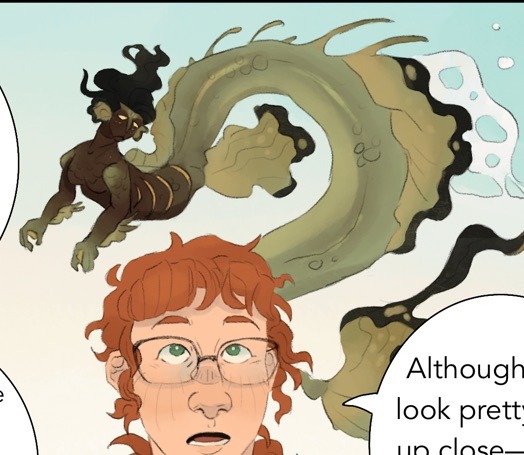
2) Yes! eggs are laid by a female in warm, shallower waters, usually reefs, siren grow up by themselves so the reefs allow them to learn how to hunt the abundant smaller fish. Also, the first born siren will then proceed to eat all the other eggs 💔
3) Pups reach a few feet before hatching, once they hatch they experience rapid growth for the next few years.
4) Technically they don’t die of old age, however the average life span tends to be around 100 years from a combination of interspecies fighting and human hunting (most boats are required to be armed with anti-siren measures). This average is a bit misleading however, most siren either die young (<50) or live much longer than 100.
5) They do in fact live in all parts of the ocean!! The example you give is actually very close to etho, with his small bioluminescent flecks, pale sickly redish coloring, and weak oxygen organ (though it’s still there). However with the size, he’s much larger due to deep sea gigantism. Siren closer to the poles tend to have much more fat storage to keep warm and are mostly black and white while siren in warmer waters tend to be smaller and more nimble to weave between coral. The only body of water they don’t populate is freshwater lakes or rivers, though some have gotten used to the brackish waters of coasts and gulfs.
Don’t apologize, answering questions is one of my favorite parts of the au!!!
102 notes
·
View notes
Text
Today I want to talk about the Pacific Northwest Tree Octopus (Octopus paxarbolis).
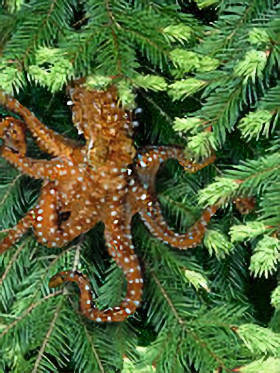
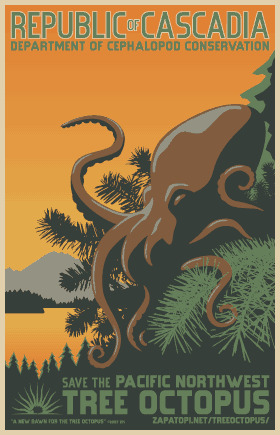
OK, so for those who don't know, the PNW Tree Octopus was an internet hoax created in 1998 consisting of a website detailing the animal's life history and conservation efforts. It's completely fake - saying that up front. This animal never existed.
But if you look at this from a speculative biology standpoint? It's genius.
There is one, and only one, thing preventing Octopus from colonizing and being hugely successful in terrestrial environments in the PNW, and that's the fact that no cephalopod has ever been able to overcome the osmotic stress of inhabiting freshwater. We don't know why this is; other mollusks evolved freshwater forms just fine. But if you hand-wave away that one, single limiting factor, the PNW is just primed for a terrestrial octopus invasion.
The Pacific coast of North America is an active tectonic boundary, meaning the coast transitions pretty much immediately into the Cascade and Coastal mountain ranges (contrast with the east coast and its broad Atlantic plain). It's also a lush temperate rainforest, with very high precipitation. This means lots and lots of high-gradient mountain streams with lots of waterfalls and rapids and cold, highly oxygenated water, and not as many large, meandering rivers.
This has important consequences on the freshwater fauna. For one, there are not many freshwater fish in the Pacific Northwest - the rapids and waterfalls are extremely hard to traverse, so many mountain streams are fish-free. There also just isn't much fish diversity in the first place - there's sturgeon in the big rivers, salmonids, a few sculpin and cyprinids and... that's pretty much it. These cold northern rivers are positively impoverished compared to the thriving fish communities of the Mississippi or Rio Grande.
Few fish means few predators, and depending on the size of the first freshwater octopus, salmon and trout just wouldn't be much of a threat. And while these rivers don't have much in the way of fish diversity, there's lots of prey available - crayfish, leeches, mosquito larvae, frogs and tadpoles, water striders, and other aquatic insects, just to name a few. So the first Octopus pioneers to invade the rivers would be entering what essentially amounts to a predator-free environment with lots and lots of food and no competition. Great for colonization.
These ideal conditions get even better once you get up past the rapids and waterfalls, since there's no fish whatsoever in those streams. Octopus, with their sucker-lined arms, are perfectly equipped to navigate fast-moving, rocky-bedded streams and climb up cliffs. They'd also be well able to traverse short stretches of dry ground to access even more isolated pools and ponds. In fact, once Octopus overcome the osmoregulation problem there's nothing at all preventing them from colonizing land in earnest, since the PNW rainforests are so wet; there's no danger of drying out.
Finally there's the question of reproduction. Octopus are famously attentive mothers, because they need to keep the water around their eggs moving and well-oxygenated. In a mountain stream, this wouldn't be an issue, because the cold, turbulent water holds lots and lots of oxygen. Breeding in high mountain streams would be ideal, and the mothers might not even need to attend to their eggs, freeing them up to evolve away from semelparity and allowing them to reproduce more than once in their lives; their populations would thus increase rapidly and dramatically.
I think, if octopus managed to invade freshwater ecosystems in the PNW, it would dramatically change the ecology much like an invasive species. They'd be unstoppable predators of frogs, bugs, slugs, maybe even larger animals like snakes, birds, and small mammals. Nothing would eat them except maybe herons, and things like bears and raccoons would give them a wide berth due to their venom. They would rule that landscape.
The tl;dr is that the PNW is primed for invasion by cephalopods, if only they could manage to overcome the osmoregulation problem and live in freshwater. If the Pacific Northwest Tree Octopus really did exist, it wouldn't be a shy and reclusive species on the brink of extinction; it would be a pest, an invasive, overpopulated menace you couldn't get rid of if you wanted to. I can just imagine them crawling up onto people's bird feeders and either stealing the nuts or luring in unsuspecting sparrows and starlings. They would sit in the trees and throw pinecones at hikers for fun. They would be some unholy mixture of snake and slug with the personality of a magpie and I am incensed that they only exist in fiction.
#long post#octopus#speculative biology#speculative evolution#spec bio#spec evo#pacific northwest#pacific northwest tree octopus#truly a shame that there are no freshwater or terrestrial cephalopods
319 notes
·
View notes
Note
So how does magic, gods, and other supernatural nonsense work in the new blightseed?
The biggest material difference between this world and our own is an objectively existing parallel plane that leaks into the material plane at certain points and makes the 'laws' of the material plane more malleable where they cross (rift zones). It has many names but 'the Ether' and 'the Dreamlands' is what's used most commonly in my writing.
The Ether has both sentient and non-sentient 'fauna' that frequently cross into the material plane. Most come and go unnoticed, but those that are noticed are highly susceptible to influence by an observer- frequent observation will shape Etheric fauna into fixed forms and ascribe qualities to the fauna that the witness believes it to have. It's sort of an unknowing dream-dreamer relationship.
An Etheric lifeform that is repeatedly observed and becomes culturally established may gradually be shaped into what we would describe as a spirit, supernatural entity, or even a god, and develop some of the reality-altering abilities ascribed to them. (note that this relationship is not even CLOSE to well-known or understood, and tends to be only theorized by devoted scholarly groups or the knowledge of peoples historically living close to rifts).
THAT BEING SAID.....
GODS/RELIGION/THE SUPERNATURAL:
Assume it functions basically the same as real life (with some additional nuances). There is no more of what most would consider 'definitive'/'material' proof of creator deities/the afterlife/etc than there is in real life. Cultural/religious groups see evidence of their gods and other religious elements in the world, but it's nothing ''''solid'''' per-se. (IE you could be an atheist in this setting without anything directly contradicting your beliefs)
However there is the aforementioned etheric fauna that are have functionally been shaped into gods/supernatural entities via observation and belief. Some folkloric entities are material Etheric fauna, but just as many legendary monsters are in the realm of mythology and belief. I'll mostly call deified Etheric fauna 'living gods' which is an in-universe scholarly term in the Great Gate region.
FOR EXAMPLE: the Nekh demigod Hai-Taihe materially exists as an unkillable talking dog with a sword that is physically encountered by travellers, she was once Etheric fauna who has been shaped into a living god through over a thousand years of belief and veneration. The Nekh 'river queen' spirits said to haunt fishermen, (depicted as gigantic river kings with female elowey attributes) are widely believed in and encounters are claimed, but there is not necessarily a physical entity running around with those characteristics (who knows, though?).
Magic:
Magic DOES materially exist, but it's incredibly subtle and there is no clear and objective line between folk belief/witchcraft and 'actual magic', no single in-universe word to describe the phenomena, and no one in-universe can make definitive factual statements on how exactly it works, what powers it, where it comes from, etc.
Observations made through rigorous magical scholarship tends to connect magic with the Ether (as its effects are strengthened in rift zones) and identify magic as will made material, influencing possible physical outcomes by concentrated willpower. A person can influence a moving ball to roll off a table more easily than to influence a motionless ball into rolling. It's effects can be strengthened through practices affecting consciousness such as psychoactive substance usage, meditation, oxygen deprivation, heightened emotional states, dreaming, etc.
Any sophont is capable of magic, but the degree of practice and mental control required to generate practical results makes its usage relatively insignificant in the grand cultural schema, and has had fairly minimal impact on the technologies of this setting. And as in real life, forms of magic/witchcraft/rituals etc are practiced without necessarily generating any unambiguous material effects (while still being believed effective).
There is absolutely nothing inherent to sophonts that allows for their magic usage, it's just that animals who do not have abstract cognitive abilities typically cannot work magic by the nature of it needing abstract cognition to work. (there are a few exceptions with non-sentient animals who have, via natural selection, developed highly specific forms of magic (usually used for predator evasion))
#bottom line is 'it's ambiguous'#I as the author have a fairly solid idea where the lines are drawn but I intentionally refuse to make them clear because it's not the point#It would kind of directly defeat the purpose of how I set it up to be like 'actually these people are WRONG about their religious beliefs'#And ppl in-universe who claim authority on the subject MIGHT have more accurate logistical understandings than others but they don't#fully understand it either and are sometimes flat out wrong and often heavily tinged by their own cultural norms and forms of xenophobia#blightseed
72 notes
·
View notes
Note
Some friends and I are planning to play a superhero-themed RPG and I'm planning a girl who has limited shapeshifting to give herself features and abilities of aquatic life. Things like octopus camouflage and tentacles, bioluminescence, electric pulses, venomous stingers, etc. And I was curious if you could recommend some really strange and obscure adaptations that could be fun to use, or a source to find information on said strange adaptations :)
Oh you’re in luck, the ocean is full of crazy and cool adaptations of animals! I’m just going to be naming any and all that come to mind in a random order because upon hearing this question I got like a million ideas at once. Stargazer fishes have both electricity impulse-generation ability and venomous spines. Hagfish are a classic, they can secrete tons of super sticky slime. Boxfish can excrete poisons from their skin into the water, and their relatives pufferfishes and porcupinefishes can have several toxins in the skin and organs. Many coldwater deep sea fishes like wolf eels have antifreeze proteins in their blood to survive in the freezing water. Some fishes that sometimes live in low-oxygen environments can respire anaerobically by producing ethanol, for example crucian carps and other carps too I think (goldfish for example). Others have specially evolved swim bladders or highly vascularised tissues in the mouth or have a special derived organ of the gills that can also take in oxygen from the atmosphere to supplement low oxygen, but likely your RPG will take place on land anyway so. Parrotfish have 15 rows of teeth that form a hard beak, the beak is formed from the second strongest biomineral in the world and the parrotfish can scrape rocks and even chew coral with it. The strongest biomineral in the world belongs to chitons, a fellow aquatic mollusk that also scrapes things off of rocks. Cone snails have a venomous harpoon-like radula tooth which they can shoot (their radula “tongue” still attached) at prey and predators alike, paralysing small prey instantly and even killing humans. They even have a radula sac where they store the rest of their radulas, ready for use! Moray eels have a second, tiny pair of jaws that help with grabbing onto prey. Tunas and billfish (and some sharks) can heat up their eyes and brain to gain superior vision while hunting. Also both can change colour — many fishes do in fact. Salmonids can smell their home river while migrating back from the ocean, which requires a phenomenal smelling ability. Besides smell many fish have taste buds all over their bodies, usually focused on any barbels and their faces, like in catfish or sturgeon. Many fishes can sense electricity via ampullae of Lorenzini, famously sharks and paddlefish. Elephantfish sense and communicate with fellow elephantfishes via low frequency electricity. Many fishes have extendable mouths, lips, or jaws, like the goblin shark, slingjaw wrasse and john dory to name a few. Seahorses are ridiculously good predators — though granted, their prey is copepods — that vacuum in their prey through their tubular mouth by jerking back their head. Cuttlefish can cause seizures in their prey by rapidly changing colour. Some squids have teeth in their suckers. Zebrafish can regenerate up to 20% of its heart. Sea stars can regenerate a whole new sea star from a severed arm. Electric eels have their powerful shock, and it is even proposed that they could be able to force their prey out of hiding by generating electricity that moves their muscles.
That’s some that came to mind! And you already mentioned bioluminescence, haha! I named so many things that it’s probably best that you go see more information about each on your own, I think sources are pretty simple to find if you just look up these things with important keywords. Hope this helps!
40 notes
·
View notes
Text
Perfect Paradise Ch.28: I'm Your Future Past and Present, I'm the Fine Line
Summary: ... I am not really here. I'm an Intrusion.
---------------------------
Emma stared up at a red sun in a red-orange sky. The alien colors brightening to yellow as the firmament neared the mountainous horizon.
'Keep up!' Morgana called as she walked down the mountain slope.
The desire to not be left alone under an alien sky kicked Emma into a run. 'Where are we?'
'The Valley of Juru on the continent of Lurvan, southern hemisphere of the planet Krypton, orbiting the sun Rao.'
Emma stopped dead in her tracks as she stared after Morgana, who kept going. "... What the actual fuck?" she exclaimed aloud, hurrying to catch up.
Morgana laughed.
'How can we breath?'
'That's a myth. The air might be less oxygen rich but Krypton's atmosphere is perfectly breathable.'
Now that Morgana mentioned it Emma was a bit lightheaded. Her body heavy under the greater gravity of this dense world... Which was exactly what you wanted scurrying past the edge of a cliff. Sure it was a short cliff but her bones wouldn't refuse to break over a little thing like that.
'Why are we on Krypton? How are we on Krypton? Isn't it supposed to be a cloud of highly radioactive space debris?'
'Well it's still highly radioactive,' Morgana pointed out.
Even with Krypton's multiple magnetospheres and dense atmosphere the periodic solar flares of the red dwarf star left the planet's surface with a higher background radiation than Earth standard.
Emma remembered all this from school and was not in the least reassured. 'Oh, great!'
'Relax, Emma. We are only here as observers.'
'The pebble in my shoe says otherwise.'
'Yes, you are very present aren't you?' Morgana gave her that knowing look again. 'Try distancing yourself for a moment.'
Emma closed her eyes and for a disorienting second she was in two places at once. Back on the roof of a Parisian arcology and standing on the mountainside of a dead world. She shuddered then opened her eyes.
The pebble was gone and her body felt lighter but the ground was still solid under her feet. And she could smell the fields of alien crops on the wind. An earthy, familiar smell despite the cold wind and violet plants.
Juru was a large valley, it's distant edge invisible in the morning mist. The land around the central river was dedicated to agriculture while the mountain slopes were left forested. In the center of the valley was a city unlike any Kryptonian architecture Emma had ever seen.
School showed her great spires of shining metal and deep artificial chasms of living crystal. But the city of Juru was so old it was made of painted stone. Murals showing gods and myths not taught by the priests of Rao. It's pyramidal shapes weren't temples or tombs like they would be on Earth. A ziggurat may have storehouses at the base; homes and shops in the middle levels; and shrines, schools or public gardens at the top. Complete with running water. Bridges and canals giving the city a three dimensional feel.
As they came closer Emma saw why: the people of Juru were flying. Not with Kryptonian hovercrafts but under their own power.
'How?'
'Look closer.'
A girl roughly Emma's age stepped onto the ledge of one of the bridges. Her clothes had no House crest though they were as fine as any of the Great Houses Emma had seen in the history vids.
The girl clapped her hands together and held them as if in prayer. Then turned her left palm so the fingers pointed down while the right remained pointing up. She separated her hands and Emma covered her eyes as a sun bloomed in the space between them.
Then the light was gone and the girl was flying.
Emma felt goosebumps over her skin.
'These are the Wizards of Juru, Emma,' Morgan's thoughts were gentle. 'The last bastion of magic on Krypton at the end of the Seventh Age.'
'... The Seventh Age? But that means...' Emma looked closer at the city around her.
Cracks branched across the public murals. Some of the street lamps had broken bulbs. Children still played in the market but the smiles of the adults were strained. A group of wizards hunched over a tablet-like device and murmured at the ill news that came from beyond the valley.
'Yes,' Morgan confirmed. 'these are the last days of Krypton.'
The Temple of the Orb rose over the city at its very heart. So large it spanned over the great river that ran through the city. Emma felt the heat of the Wizards' power in the very stones under her feet. No cracks allowed here. Here the murals spoke of the very founding of the world and how the gods had blessed the first Wizards of Juru with their magic. Across the chaos of the Second Age and the ice age of the Fourth, Juru stood as a bastion of Kryptonian culture.
Then the colonizer Val-El came and the Great Houses of Kandor never allowed the Valley of Juru to lower their guard again.
Emma stopped.
A circle split in two caught her eye. A Nightwing and a Firebird circled each other in an endless dance. Neither seeking dominance over the other. Rays of red and black rained their blessings down upon the land, gifting Krypton with life.
The Firebird flared brighter. Flying faster. Overtaking his brother-self. The black lines ran red. Jungles were covered in towers of crystal. The Nightwing could not stretch his wings. With every turn of the cycle he was squeezed smaller and smaller and smaller until the Nightwing was but a dot amid the fires of Creation.
And then he burst free.
Wings spreading across the sky as cracks radiated from his splendor. Green ice flared across the land. The Nightwing's shadow devoured everything. Destruction unleashed in a single glorious moment of beauty and terror.
'Emma.'
Emma's head snapped towards the sound of Morgan's voice. She blinked and the golden glow of her irises faded back to a dark brown.
If Morgan noticed she gave no sign. 'Come. We must bear witness.'
Emma looked back at the mural. The Firebird and Nightwing circled each other in endless harmony...
(Read the rest on AO3)
#ml#miraculous ladybug#ml au#Perfect Paradise#ml fanfic#ml crossover#krypton#valley of juru#house of el#time travel
3 notes
·
View notes
Text
An oil tanker carrying jet fuel was recently hit by a cargo ship while at anchor 13 miles off the east coast of England. This set off a series of large explosions and a huge plume of black smoke, while a still unknown quantity of jet fuel has spilled into the sea.
We’re marine ecologists at the University of Hull, the city nearest the incident. We know this coast and these seas very well. While it’s too early to say exactly what the consequences will be, we do know that this spill puts at risk one of Britain’s most important stretches of coastline—both for conservation and for commercial fishing.
The collision occurred in the Holderness offshore marine protected area, a region of coarse sandy seabed that supports lots of different species. These include the ocean quahog, an edible clam known to live for over 500 years. The area also acts as a nursery for fish like lemon sole, plaice, and European sprat.
This area overlaps with those designated to protect harbor porpoises and the nearby Humber Estuary and its mud flats, sand dunes, and marshes where thousands of birds spend the winters alongside other important species, such as lampreys and gray seals.
The UK’s largest mainland breeding seabird colony is found just north of the collision site, along the Flamborough and Filey coast. More than 250,000 birds nest there every year, including impressive numbers of guillemots and razorbills. It also hosts species of conservation concern like gannets, kittiwakes, and puffins.
To the south are other protected coastlines and an important breeding site for grey seals. The Wash, where four rivers empty into the same large square-shaped estuary, is found 70 kilometers to the south, in the general direction of drift from the tanker collision. The area has large salt marshes and is another important site for over-wintering birds.
The spill has taken place in a productive fishing area that supports the largest crustacean fishery in Europe, with about £15 million of live lobster landed annually. The mix of coarse sand and cobbles on the seabed provides ideal nursery ground for lobsters as they can create burrows under perfectly-sized stones.
How This May Affect Life in and Around the Sea
Given the ecological and commercial importance of the region, people are right to be worried by the possible effects of spilled aviation fuel, air pollution, and deposition of contaminated soot from the smoke plume. While it is too early to comment on the potential severity of the fuel spill, the nature of the contaminant and the environmental conditions allow us to make some assumptions.
Jet fuel is thinner than crude oil and spreads rapidly to form a film on the surface of the water. It is unlikely that the fuel spilled would lead to heavy oiling of birds or the formation of tar balls and smothering of the sea bed by oily material, as can happen after crude oil spills.
Conditions at the spill site are highly dynamic. There is therefore a good chance the fuel will mix into the seawater below, breaking up the surface slick, potentially exposing the seabed to contaminants. Strong currents, wave action, and relatively coarse sediment help oxygen to mix into the water and sediments, which helps the fuel to degrade more quickly.
In calmer areas areas, particularly where there is lots of sediment suspended in the water (such as within the Humber estuary and parts of the Wash), there may be potential for contaminants to adhere to fine particles in suspension and subsequently sink to the seabed. Fuel will likely take longer to degrade in organic-rich, fine-grained, and poorly oxygenated sediment within the estuary than in offshore areas.
While the conditions at sea favor degradation, jet fuel is highly toxic and will likely impact species in the water ranging from tiny plankton at the base of the food chain, up to the predatory birds, seals, porpoise, and dolphins at its top.
Animals at the surface and those that regularly break through it to feed or breathe will be especially affected by direct contact with the surface slick. Though seals breed between late October and December, there are still seals at the nearby breeding sites, potentially including young seals.
Even if we do not see high levels of mortality, the incident could not have come at a much worse time for birds as they prepare for breeding season. Adults birds challenged by toxic fuel over the short term may suffer reduced reproductive fitness, although it’s difficult to say for sure at the moment.
It will be some time before we really get the full picture. We still don’t know how much fuel was spilled, its chemical composition and toxicity, how it behaved once it hit the sea, where it will end up, and how long it will last. All these factors will be important if we are to understand how this incident will affect the environment.
3 notes
·
View notes
Text
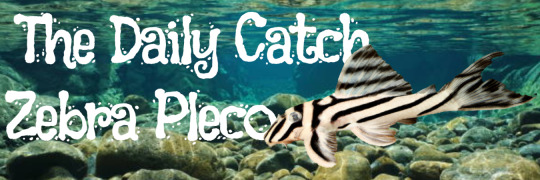
Zebra pleco (Hypancistrus zebra)
Critically endangered
Stripy guy!!!
Zebra plecos are a really funky fish :3 Partly just because they’re in the loricariid or suckermouth catfish family, along with those massive common plecos and the tiny little ottos, so they have a mouth like a suction cup and huge spiked bony scales like some kind of wicked looking fantasy armor growing just under their skin. Partly also because they look like tiny zebras, and partly because they’re kinda odd even for a suckermouth catfish.
They’re probably the smallest pleco at around 3 inches long, but somehow they manage to live even longer and slower than the gigantic ones - they can easily take four or five years to grow to maturity and stay alive for a couple decades.
Also, other plecos and ottos are known for eating a lot of algae - enough that people call them a “cleanup crew” for their aquarium, as if these little creatures were always destined for a career as janitors. Zebra plecos sure weren’t though - they’re the only member of their family that’s a predator.
Their ancestral home is the crystal clear water of the Rio Xingú in Brazil, a fast and powerful river, highly oxygenated and energetic, and full of huge volcanic boulders that the plecos cling to for their lives. Each pleco claims its own boulder and defends it fiercely, so it can use the holes in the rock to hide from pike cichlids and spend the night munching on crustaceans, worms, and other invertebrates that cling onto stones just like the fish does - the whole ecosystem is constantly battered by the crashing water.
…it was at least. The Brazilian government, with its boundless contempt for biodiversity, decided to construct the Belo Monte dam directly on the Rio Xingú. The whole river is now either permanently flooded or permanently dry, depending which side of the dam it's on. Multiple endemic species are now likely to go extinct very soon. Living in the middle of such a powerful river seems harsh to us, but it’s what they need to survive. Stagnant lakes and trickling streams just aren’t enough.
People have tried rescuing some zebra plecos and moving them to similar rivers nearby, but for some reason it hasn’t worked. The only thing that has worked, and luckily pretty well, is caring for them in our own aquariums. And they’re sweeties so let’s learn how :3
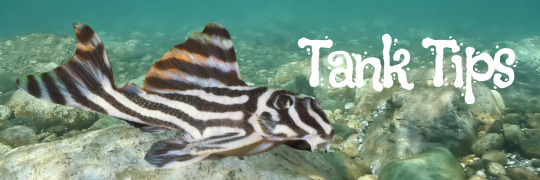
The only problem with keeping zebra plecos is that they’re new to the fish trade and they don’t breed fast, so they’re really expensive, but thank goodness they’re getting more accessible as we speak and they should be a lot cheaper soon so keep an eye out for when they are.
Other than that their care isn’t super duper simple but it’s definitely doable. The tank should be at least 30 gallons for a small group, they don’t need anything huge since they’re tiny and they all pick their own little spots to stay in. They LOVE rocks, give them lots of rocks- in big piles full of little caves where they can all find their own spot to chill during the day (they’re mostly nocturnal and shy but they come out for food). They’re very territorial, so a zebra pleco tank should look a lot like an African cichlid tank - lots of different rock piles and at least a couple different caves for each fish, and sightbreaks so they don’t have to look at each other all the time… its pretty awkward (and upsetting) for them to stare at their neighbors all day…..
Like I said earlier they need fast water flow, so make sure you have some kind of pump or powerhead or large filter to give them that. Try not to blast water directly into the caves or they won’t use them. They also need really warm water, like 79-86 degrees F, and lots of dissolved oxygen, so make sure you have a good bubbler. The bubbler is especially important since warmer water can’t hold as much oxygen. They need rlly clean water too so do regular water changes. They’re okay in a pH of 6.5 to 7.5 but they prefer less than 7, and they’re generally adaptable to different levels of water hardness but if it’s too hard the shells of their eggs can thicken and make it impossible to hatch, so be aware of that if they lay eggs.
Zebra plecos are perfectly fine on their own, but it’s best to have a small group since you really should try to breed them. They usually breed a lot more at around 85 degrees F. Try to have at least two females for every male to spread out the aggression, since males are usually a lot more aggressive. When they’re ready to breed, a male will try to entice a female to swim into his cave, where she’ll stay for 1-5 days laying eggs while the male guards the entrance. Then the male fertilizes the eggs and takes care of them until they hatch a week later and the fry leave in search of food after using up their yolk sacs three days after that. He stays constantly vigilant for predators and fans the eggs with his tail the whole time to keep them clean and oxygenated. Plecos are very good parents :3
They’re pretty chill with their own babies and they never really bother them about anything. Same for other fish species; plecos are fine with anyone except a rival pleco intruding on their territory, but even then their little squabbles never really cause any serious injuries. Make sure whatever you put in the tank with them is small, slow, and calm, or it’ll snatch up all the food before the plecos can get any. Also, they love eating snails, so I’d suggest ottos instead as an algae eater.
They need a meat-based diet like what they’d get in the wild, but it’s good to give them some veggies like zucchini as a supplement. Some of their fav meats are bloodworms and brine shrimp (the babies will eat the same stuff as their parents if you crush it into tiny bite-sized bits), but the most important thing is that the food can sink - otherwise they just won’t eat it since they love slurping worms off the ground like little dogs eating the spaghetti you dropped at dinner… they usually wait for food to naturally drift to their own rocks so make sure you spread it around the tank for them.
Zebra plecos are a little weird and shy and I love them for it. Hopefully it won't be too long before we can all take care of some :3
11 notes
·
View notes
Text
HELLBENDER HELLBENDER HELLBENDER
(Cryptobranchus alleganiensis for disambiguation)
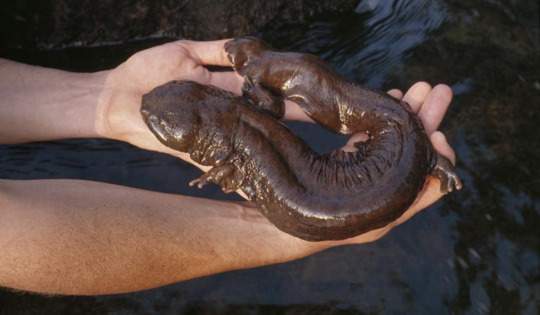
The largest salamander in North America and third largest in the world, the Eastern Hellbender gets its scientific name from the Allegheny River. It is also the largest amphibian in North America, if you go by weight!
The hellbender is totally aquatic and uses its skin wrinkles to increase its surface area to allow for respiration, as they have no gills as adults. This means they need very clean, fast moving, highly oxygenated water.
They live under rocks! Each one picks its own rock and chases others away from that tiny territory.
Captive hellbenders have been documented to live about 30 years, although some researchers believe that they could have lifespans of up to 50 years old or older in the wild!
They also have cute little toesies!

It was said that at one time you could go to rivers in their range and turn over any rock to find a hellbender, but their population has declined drastically since the 1980s. This decline is largely driven by human activity such as habitat loss/degradation (dams, locks, silting, etc.), water pollution and acidification due to mining and fracking, and over harvesting for both the scientific and pet industries.
They’re listed as a Vulnerable species by ICUN, though some researchers argue that there are at least two genetically distinct subspecies and that one of them (the Ozark hellbender) should be considered endangered (and is under the USFWS).
Most of the remaining population of hellbenders is found in protected areas like state parks and wildlife reserves.
Fortunately, efforts at increasing awareness of this species have generally created a positive public opinion towards these little guys, which is the first step towards enacting policies that protect their environment.
Let’s see one more beauty shot before we go:

Reply or reblog with facts about your favorite fish / aquatic animal. This is the official Water Creature Infodump Post!
859 notes
·
View notes
Text
Wet Beast Wednesday: spiny softshell turtle
It may be neither Flat Fuck Friday nor Turtle Tuesday, but because this is my series and I can do what I want, I'm talking about a very flat turtle. The spiny softshell turtle (Apalone spinifera) is the most widely distributed and possibly the most common softshell turtle in North America. Its range covers most of the Eastern half of the USA and stretched into Canada and Mexico. There are 6 subspecies separated by geography and hybridization can happen in places where their ranges cross. Hybridization has also been known to happen with the Florida softshell (Apalone ferox). The subspecies are the northern (A. s. spinifera), gulf coast (A. s. aspera), Texas (A. s. emoryi), pallid (A. s. pallida), Guadalupe (A. s. guadalupensis), and black (A. s. atra) spiny softshells.
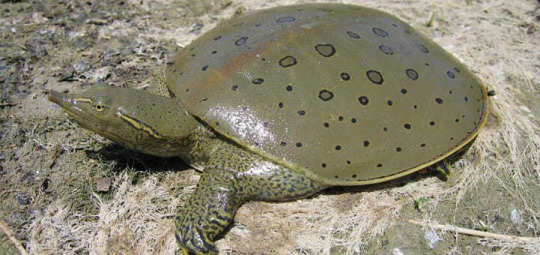
(Image: a spiny softshell turtle seen from above and to the side. It is a turtle with a wide, flat shell. Its head and one foot are visible. The head is skinny and has an elongated nose. The foot is wide and flat, with webbed toes. The turtle is an olive green with black dots on the skin, yellow stripes on the face, and dark spots on the shell. End ID)
The thing that makes a softshell a softshell is the lack of keratinized scutes on their shells. This makes the shells smooth and leathery. The center of the shell has a layer of solid bone user it, but this does not extend to the edges of the shell, making it less rigid. Softshells are the fragile speedsters of the turtle world. Their shells are a lot lighter and often more streamlined, allowing for faster movement both on land and in water, but they provide less defense. Spiny softshells have spiny projections along the front edge of the carapace (upper shell), with males having more than females. They are some of the largest North American freshwater turtles. Females can reach a carapace length of 54 cm (21 in) and 11 kg (25 lbs) while the smaller males max out at about 25 cm (10 in).
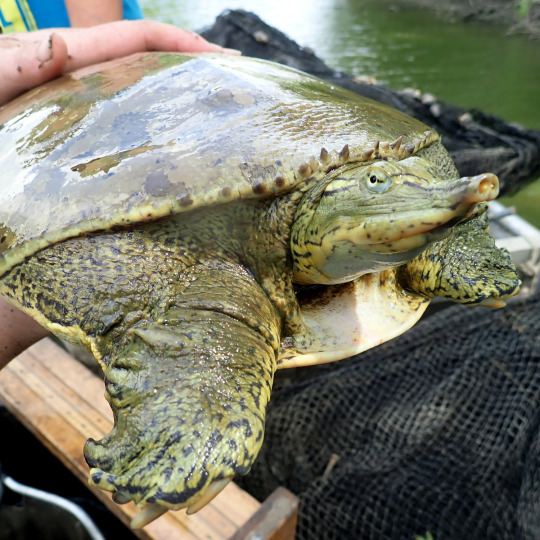
(Image: a spiny softshell being held by a person, seen from the front. The leading edge of the carapace is visible, showing off the small spines. End ID)
Spiny softshells have wide, flat, paddle-like feet with three claws and an elongated nose that acts like a snorkel. The turtles are born a bright olive color with striped faces and dark spots on the shell. Males keep their juvenile coloration for their entire lives while females grow darker ad lose many of their markings. It can be very difficult to tell females of different subspecies apart, while males and juveniles can be distinguished by their markings. Smooth skin and highly vascularized membranes in the cloaca, mouth, and throat allow the turtles to breathe by diffusing dissolved oxygen from the water into their blood.
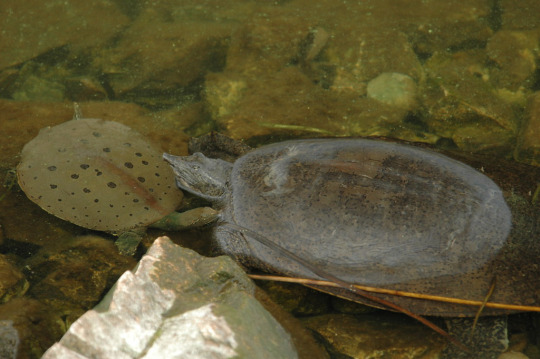
(Image: a male and female spiny softshell facing each other. The male is less than half the size of the female and has an olive colored shell and skin, with dark spots on the shell. The female is a uniform muddy brown color. End ID)
Spiny softshells are generalists able to live in a wide range of habitats. They prefer streams, rivers, and ponds with muddy or sandy bottoms and high visibility, but can live in most freshwater habitats. Softshells are diurnal, spending their days basking and feeding. Being turtles, they are ectothermic, meaning their body temperature matches the surrounding temperature. To warm themselves up, the turtles bask in the sunlight. They can often be found resting on exposed rocks, logs, sandbars, or shorelines. While not particularly social animals, the turtles will bask in groups. When threatened, softshells will attempt to swim away and/or bury themselves. In the right sediment, a softshell can bury itself in under a second. Because their shells are less rigid, softshells have to actively defend themselves when cornered and will bite and scratch. People have to be careful when handling them. They brumate (that's hibernation for reptiles) during winter. While brumating, they bury themselves underwater and slow their metabolism and oxygen requirements. In this state they can fully sustain themselves on oxygen absorbed through their skin or special membranes.
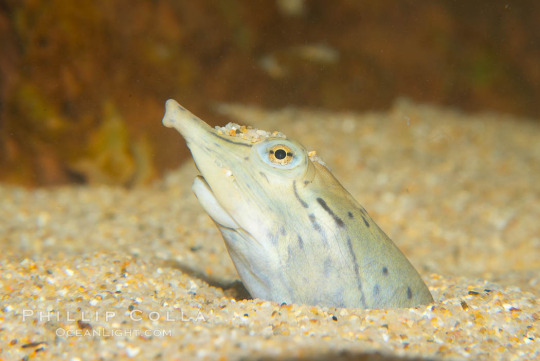
(Image: a spiny softshell turtle buried in its hunting strategy. Only the head is visible above the sand. End ID)
They are primarily carnivores and will eat anything that can fit in their mouths. Aquatic insects, crayfish, worms, amphibians, mussels, snails, fish, and more are on their plate. While capable of fast swimming, they are not pursuit predators. They employ two primary hunting strategies. The first is to bury themselves in the sediment and wait for prey to come by. The second is digging in the sediment to find worms and other animals. Fish have been known to follow digging turtles around to feed on animals unearthed by them.
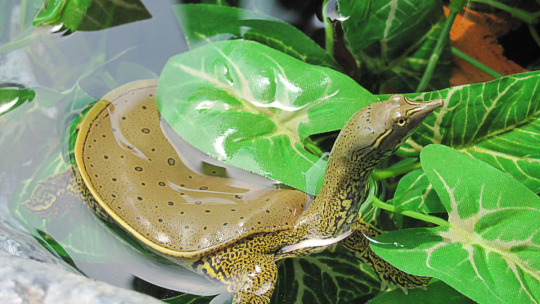
(Image: a spiny softshell in captivity. It is swimming at the surface of the water in a tank, amongst artificial leaves. End ID)
Spiny softshells mate in spring. Males attempt to woo females by swimming over to them and bumping heads together. The male then sits on top of the female to mate. Unlike most species of turtles, the males do not grab onto the female's shells during mating. Eggs are laid between summer and early fall and will hatch next spring. The female will dig a nest in sandy or gravelly banks and bury the eggs once they have been laid. She provides no further care. Females will typically mate multiple times each year, with each mating having a different nest. The juveniles take 8 to 10 years to reach sexual maturity and they can live up to 50 years in the wild. Many turtles determine sex by the temperature the eggs are incubated in. This is not the case with spiny softshells, who have genetics based sex determination.

(Image: a group of 5 juveniles. The photo focuses on two who are sitting next to each other. One has its front right leg on the shell of the other. They have similar coloration to an adult male. End ID)
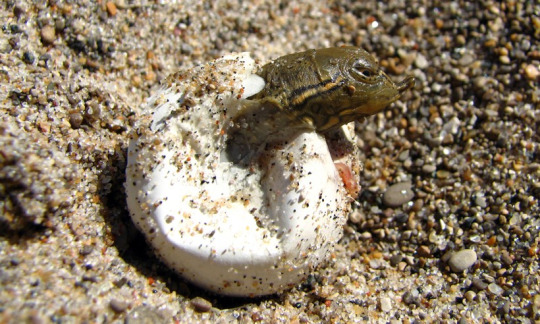
(Image: a newborn emerging from its egg. The egg is round and white, looking like a ping-pong ball. Only the head of the turtle has emerged. End ID)
Most subspecies of spiny softshell are classified as least concern or near threatened by the IUCN, meaning they are not in danger of extinction. The exception is the black spiny softshell, also known as the Cuatro Ciénegas softshell, which is critically endangered. The primary threats to the turtles is habitat loss due to human activity. Adults have no natural predators outside of the Florida and adjacent state populations, which are prey to alligators. Juveniles are eaten by a variety of animals including fish, snakes, raccoons, and herons. People will also eat the adults. Because it can take a whole decade for juveniles to become reproductive, losses in population take a long time to replace. They have been introduced to areas outside of their native range, most notably the western USA. Most of these introductions are due to people releasing pet turtles into the wild.
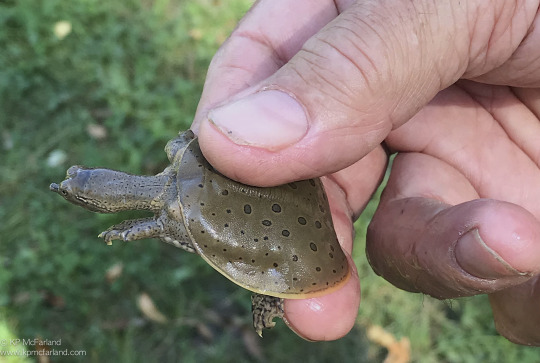
(Image: someone holding a juvenile. The shell is 2-3 times the size of the human's thumb. End ID)
#i typoed it as softhsell more times than I care to admit#wet beast wednesday#turtle#turtles#softshell turtle#soft shell turtle#spiny softshell turtle#reptile#biology#zoology#ecology#animal facts#freshwater ecology#aquatic biology#informative#educational#image described#turtle power#herpetology
80 notes
·
View notes
Text
@GakkeNoPonyo MISSION
1. Betta Splendens (Crown Tail Betta)

The Crown Tail Betta is a stunning variety of the betta fish known for its unique tail structure, which resembles a crown. These fish are characterized by their vibrant colors and elaborate fin shapes. Crown Tail Bettas are typically found in warm, shallow waters in Southeast Asia. They thrive in areas with plenty of vegetation and hiding spots.
2. Guppy (Poecilia reticulata)

Guppies are small, colorful freshwater fish popular among aquarists due to their vibrant patterns and ease of care. They are native to freshwater rivers and streams in South America, but they have been introduced to many parts of the world. Guppies thrive in shallow, warm waters with plenty of vegetation. They are often found in areas with dense plant life, which provides both food and shelter from predators.
3. Betta Fish (Betta splendens)

Betta fish, also known as Siamese fighting fish, are famous for their vibrant colors and flowing fins. Native to Southeast Asia, particularly Thailand, these fish are often kept in home aquariums and are known for their aggressive behavior towards each other. In the wild, bettas inhabit shallow waters, such as rice paddies and ponds, where they can hide among plants and debris. They prefer warm, stagnant water and can breathe atmospheric oxygen through a specialized organ known as the labyrinth.
4. Knysna seahorse (Hippocampus capensis)

The Knysna seahorse (Hippocampus capensis) is a beautiful, estuarine-dependent fish species found in South Africa. It is a small, delicate creature with a unique appearance, including a body encased in bony rings and a muscular tail. The Knysna seahorse is also known for its interesting reproductive strategy, where the male carries and gives birth to live young, making it one of the most fascinating fish species.
5. Jewel Cichlid
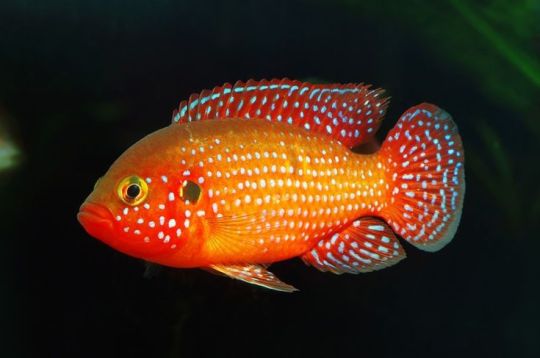
This genus of gorgeous cichlids comes from West Africa and therefore does not have the high pH and hard water requirements of African cichlids from Lake Tanganyika and Lake Malawi. There are many species that come in all sorts of colors such as blue-green and gold, but the red kinds are the most familiar ones in the aquarium trade. They can grow up to 5–6 inches (13–15 cm)
6. Mandarin Fish

The Mandarinfish is one of the most beautiful and stunning fish in the ocean. It is native to the Pacific ocean, ranging from the Ryukyu Islands south to Australia. It is a small and shy tropical fish, which is popular as a photographic subject due to its striking beauty and interesting habits.
7. Ram Cichlid

The Ram cichlid is a small, colorful, and very popular aquarium fish, which is endemic to the Orinoco River basin, in the Savannah of Columbia and Venezuela. The fish has an oval-shaped body with pointed fins and a tail. Mature males can develop more pointed dorsal fins than females.
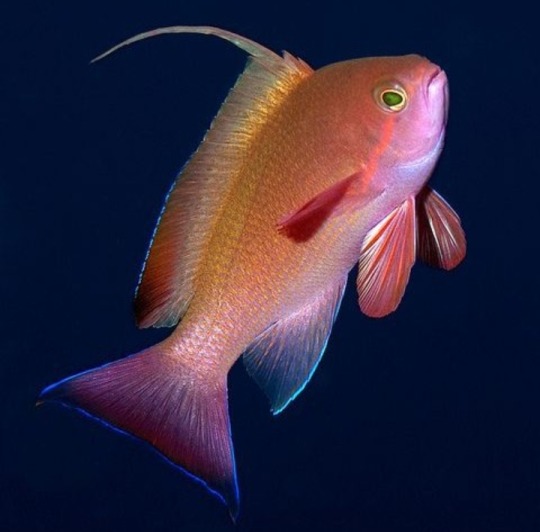
8. Sea Goldie
Found in the western Indian Ocean, including the Red Sea, and in the Pacific Ocean as far east as Japan and southeast Australia, the sea goldie is a small tropical fish that inhabits the translucent waters of lagoons and coral reefs, up to 20 metres in depth. These fish are protogynous hermaphrodites, like the other members of their family. They are born as females but turn into males at some point in their life.
9. Banggai Cardinalfish

The Banggai cardinalfish is a small marine bony fish, which is endemic to the Banggai Archipelago in Indonesia. It has been introduced outside its natural range through the ornamental live reef trade, and it is very popular in aquarium culture.
10. Platinum Angelfish

Platinum Angelfish (Pterophyllum scalare) is a strikingly beautiful variety of the freshwater angelfish, known for its bright, metallic white or silvery coloration. This variant is highly sought after by aquarists for its sleek, almost iridescent appearance and graceful swimming behavior. Native to the Amazon Basin, like other angelfish, the Platinum Angelfish thrives in slow-moving, warm waters with plenty of vegetation
1 note
·
View note
Text
Water Treatment Equipment: The Guardians of Clean Water
The Significance of Water Treatment Equipment
In our daily lives, water treatment equipment is the unsung hero that ensures the water flowing from our taps is safe to drink. Municipal water treatment plants are equipped with a series of processes to purify water sourced from rivers, lakes, or groundwater. Without these facilities, the risk of water - borne diseases such as cholera, typhoid, and dysentery would be significantly higher. In industrial settings, water treatment equipment is equally vital. Industries rely on large volumes of water for various processes. For example, in the food and beverage industry, high - purity water is required to maintain product quality and safety. In power generation, treated water is used for cooling systems to prevent corrosion and ensure efficient operation.
Types of Water Treatment Equipment and Their Working Principles
Filtration Equipment
Filtration is one of the fundamental processes in water treatment. Mechanical filters, like sand filters, use physical barriers to trap suspended particles. Water is passed through layers of sand, and particles larger than the pore size of the sand are retained. Activated carbon filters, on the other hand, work on the principle of adsorption. Activated carbon has an extremely large surface area due to its porous structure. This allows it to attract and hold organic compounds, chlorine, and some heavy metals. Reverse osmosis (RO) systems are a more advanced form of filtration. RO membranes have pores so small that they can reject dissolved salts, heavy metals, and most organic molecules. Water is forced through the membrane under pressure, and only pure water molecules can pass through, leaving contaminants behind.
Disinfection Equipment
Disinfection is crucial for killing harmful microorganisms in water. Chlorination is a widely used disinfection method. Chlorine, when added to water, forms hypochlorous acid, which is a powerful oxidizing agent. This acid penetrates the cell walls of bacteria and viruses, disrupting their metabolic processes and ultimately killing them. Ozone disinfection is another effective method. Ozone is a highly reactive form of oxygen. When introduced into water, it quickly decomposes, releasing oxygen atoms in a highly reactive state. These reactive oxygen atoms attack and destroy the cell walls and membranes of microorganisms. Ultraviolet (UV) disinfection uses UV light in the germicidal range. The UV light damages the DNA or RNA of microorganisms, preventing them from reproducing.
Chemical Treatment Equipment
Chemical treatment equipment is used to adjust the chemical composition of water. For example, in the process of coagulation and flocculation, chemicals such as aluminum sulfate or ferric chloride are added to water. These coagulants neutralize the negative charges on fine suspended particles and colloids, causing them to come together and form larger flocs. Flocculation then involves gentle mixing to promote the growth of these flocs, which can be more easily removed by sedimentation or filtration. pH adjustment is another important aspect of chemical treatment. If the water is too acidic, chemicals like lime can be added to raise the pH. Conversely, if the water is too alkaline, acids such as sulfuric acid can be used to lower the pH.
Applications of Water Treatment Equipment
As mentioned earlier, water treatment equipment has extensive applications in both domestic and industrial sectors. In addition to providing clean drinking water and supporting industrial processes, it also plays a vital role in environmental protection. Wastewater treatment plants use a combination of physical, chemical, and biological treatment processes to remove pollutants from domestic and industrial wastewater before discharging it back into the environment. This helps prevent water pollution and protects aquatic ecosystems.
In conclusion, water treatment equipment is an indispensable part of our modern society. It not only ensures the availability of clean and safe water for various uses but also contributes to environmental sustainability. As water resources become more scarce and polluted, the continuous development and improvement of water treatment equipment will be crucial in meeting the growing demand for high - quality water.
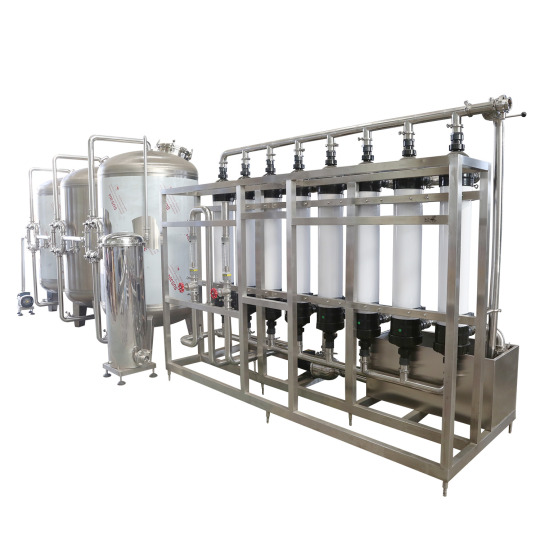
0 notes
Text
What is the Importance of Flora?
Flora encompasses all the plant species inhabiting a specific geographic area or ecosystem. It includes a diverse range of plants, such as trees, shrubs, flowers, grasses, algae, mosses, ferns, and more. These plants vary in terms of their characteristics, such as size, shape, color, and lifespan. Flora not only beautifies our surroundings but also plays a crucial role in various ecological processes.
Features of Flora
Flora consists of vegetation found both on land and in bodies of water, such as lakes, rivers, and oceans.
It helps in the process of photosynthesis, converting sunlight into energy and releasing oxygen.
Flora provides habitats and food sources for many animal species.
It contributes to climate regulation by absorbing carbon dioxide and releasing oxygen.
Importance of Flora
Flora serves various essential functions and the importance of flora are described below,
Oxygen Production: Plants, through photosynthesis, produce oxygen, which is vital for all living organisms, including humans.
Food Source: Many animals, including herbivores and omnivores, rely on plants for their food. Without flora, these animals would have no sustenance.
Habitat: Flora provides shelter and nesting sites for countless creatures, creating a suitable habitat for fauna.
Erosion Control: Plant roots help anchor soil, preventing erosion and maintaining soil quality.
Climate Regulation: Trees and other vegetation play a role in regulating local climates by providing shade and releasing moisture into the air.
Medicinal Plants: Several plants have medicinal properties and are used in traditional medicine worldwide.
Aesthetic and Recreational Value: Beautiful gardens, parks, and natural landscapes enrich our lives and provide recreational opportunities.
Biodiversity: A diverse flora supports a diverse fauna, leading to a healthier ecosystem.
Flora and fauna are integral components of our natural world, each playing a unique role in maintaining biodiversity and ecological harmony. While flora refers to plants, fauna encompasses animals, and both contribute to the overall functioning and resilience of ecosystems. Understanding the definitions, importance, and differences between flora and fauna allows us to appreciate and conserve the remarkable diversity of life on our planet.
This is all about the Flora and Fauna, and we covered in depth the importance of flora and fauna along with the difference between flora and fauna. If you’re interested in gaining a better understanding of similar concepts presented in a straightforward manner, you can explore our Tutoroot blog section. If you’re seeking top-notch online tutoring to enhance your academic performance, Tutoroot is the ideal choice for you. Click here to schedule a FREE DEMO session with our highly qualified educators.
0 notes